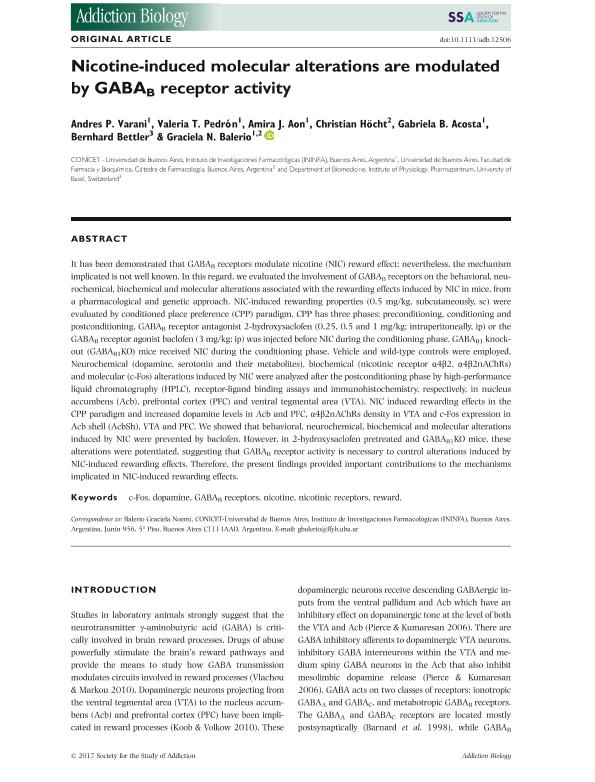Artículo
Nicotine-induced molecular alterations are modulated by GABAB receptor activity
Varani, Andrés Pablo; Pedrón, Valeria Teresa ; Aon, Amira J.; Höcht, Christian; Acosta, Gabriela Beatriz
; Aon, Amira J.; Höcht, Christian; Acosta, Gabriela Beatriz ; Bettler, Bernhard; Balerio, Graciela Noemí
; Bettler, Bernhard; Balerio, Graciela Noemí
 ; Aon, Amira J.; Höcht, Christian; Acosta, Gabriela Beatriz
; Aon, Amira J.; Höcht, Christian; Acosta, Gabriela Beatriz ; Bettler, Bernhard; Balerio, Graciela Noemí
; Bettler, Bernhard; Balerio, Graciela Noemí
Fecha de publicación:
01/2018
Editorial:
Wiley Blackwell Publishing, Inc
Revista:
Addiction Biology
ISSN:
1355-6215
e-ISSN:
1369-1600
Idioma:
Inglés
Tipo de recurso:
Artículo publicado
Clasificación temática:
Resumen
It has been demonstrated that GABAB receptors modulate nicotine (NIC) reward effect; nevertheless, the mechanism implicated is not well known. In this regard, we evaluated the involvement of GABAB receptors on the behavioral, neurochemical, biochemical and molecular alterations associated with the rewarding effects induced by NIC in mice, from a pharmacological and genetic approach. NIC-induced rewarding properties (0.5 mg/kg, subcutaneously, sc) were evaluated by conditioned place preference (CPP) paradigm. CPP has three phases: preconditioning, conditioning and postconditioning. GABAB receptor antagonist 2-hydroxysaclofen (0.25, 0.5 and 1 mg/kg; intraperitoneally, ip) or the GABAB receptor agonist baclofen (3 mg/kg; ip) was injected before NIC during the conditioning phase. GABAB1 knockout (GABAB1KO) mice received NIC during the conditioning phase. Vehicle and wild-type controls were employed. Neurochemical (dopamine, serotonin and their metabolites), biochemical (nicotinic receptor α4β2, α4β2nAChRs) and molecular (c-Fos) alterations induced by NIC were analyzed after the postconditioning phase by high-performance liquid chromatography (HPLC), receptor-ligand binding assays and immunohistochemistry, respectively, in nucleus accumbens (Acb), prefrontal cortex (PFC) and ventral tegmental area (VTA). NIC induced rewarding effects in the CPP paradigm and increased dopamine levels in Acb and PFC, α4β2nAChRs density in VTA and c-Fos expression in Acb shell (AcbSh), VTA and PFC. We showed that behavioral, neurochemical, biochemical and molecular alterations induced by NIC were prevented by baclofen. However, in 2-hydroxysaclofen pretreated and GABAB1KO mice, these alterations were potentiated, suggesting that GABAB receptor activity is necessary to control alterations induced by NIC-induced rewarding effects. Therefore, the present findings provided important contributions to the mechanisms implicated in NIC-induced rewarding effects.
Palabras clave:
C-Fos
,
Dopamine
,
Gabab Receptors
,
Nicotine
,
Nicotinic Receptors
,
Reward
Archivos asociados
Licencia
Identificadores
Colecciones
Articulos(ININFA)
Articulos de INST.DE INVEST.FARMACOLOGICAS (I)
Articulos de INST.DE INVEST.FARMACOLOGICAS (I)
Citación
Varani, Andrés Pablo; Pedrón, Valeria Teresa; Aon, Amira J.; Höcht, Christian; Acosta, Gabriela Beatriz; et al.; Nicotine-induced molecular alterations are modulated by GABAB receptor activity; Wiley Blackwell Publishing, Inc; Addiction Biology; 23; 1; 1-2018; 230-246
Compartir
Altmétricas



